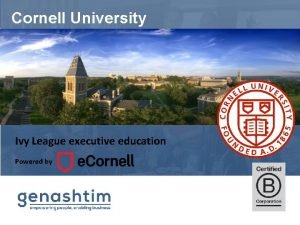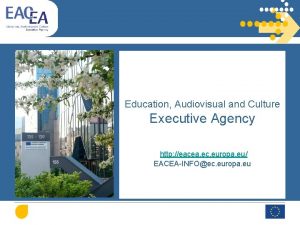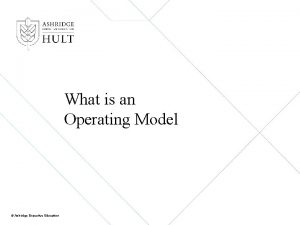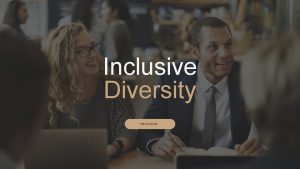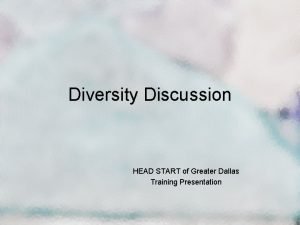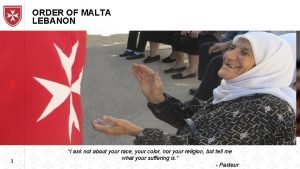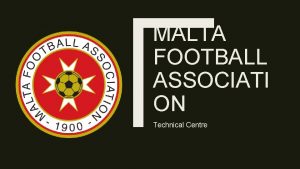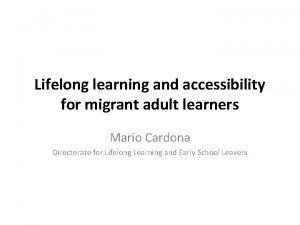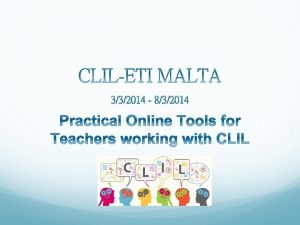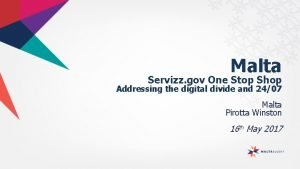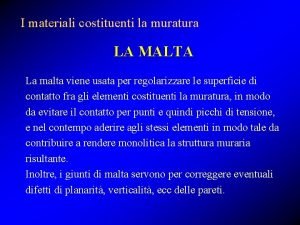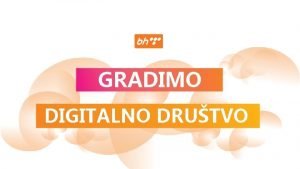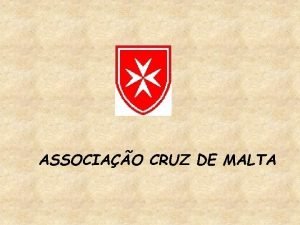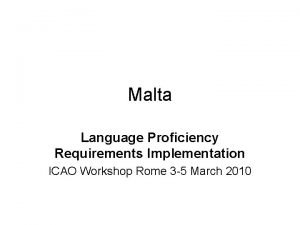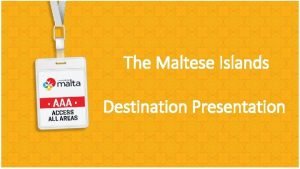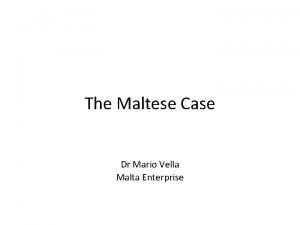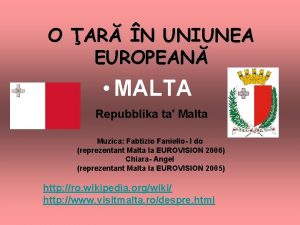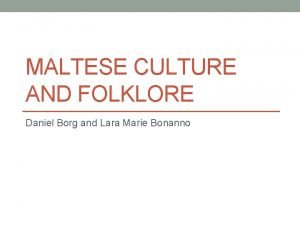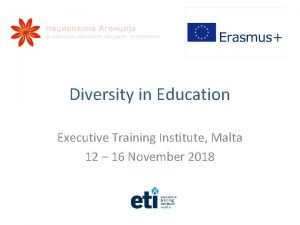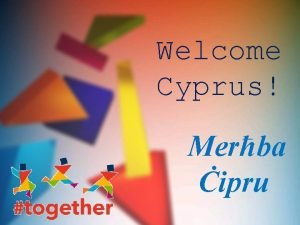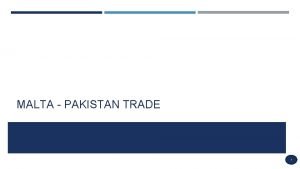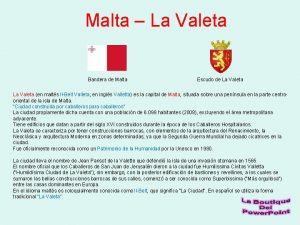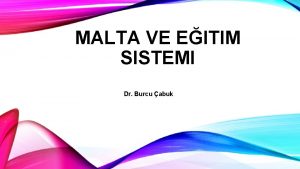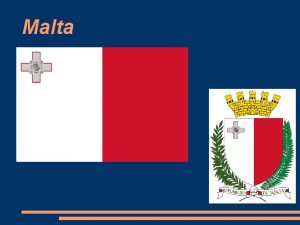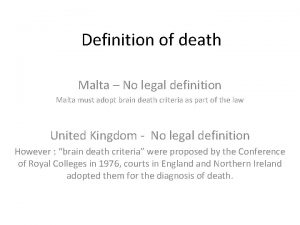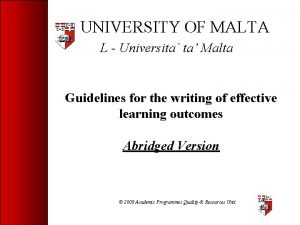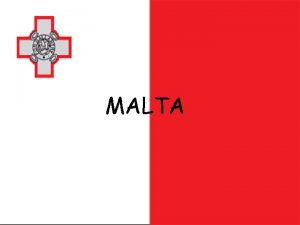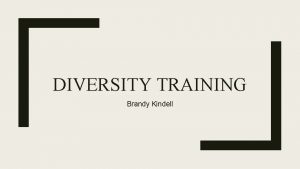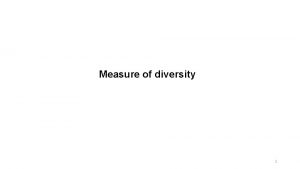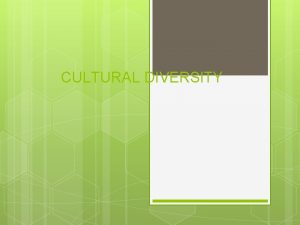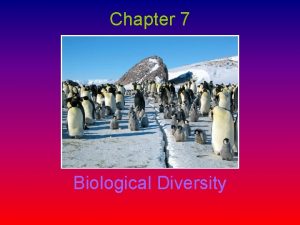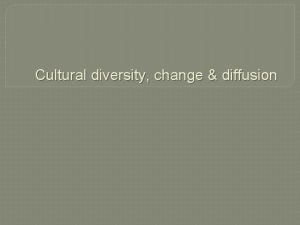Diversity in Education Executive Training Institute Malta 12
































- Slides: 32

Diversity in Education Executive Training Institute, Malta 12 – 16 November 2018

etimalta. com Professor Judie Ibbotson “There’s no right or wrong, only different. ”


Course overview • • • Culture and intercultural competences Refugees and migrants; case studies Diverse abilities; integration or inclusion Different personalities and communication skills Training plan presentation

Course objectives • Gain a better understanding of the challenges of working with diversity in education • Develop an awareness of culture and its impact on behaviour, especially communication • Develop skills and competences for working with culturally diverse groups • Gain an understanding of coping with diverse abilities • Explore solutions to the challenges of working with migrants and refugees • Gain knowledge of how to deal with different personalities • Develop a plan for integrating intercultural training into their institutions and classrooms • Develop fluency and practise expressing oneself more confidently in English

Getting to know each other D&D Skopje theatre Vesna 2006 1984 Nora How many nationalities are there in this room? How many different subjects are taught? Has anyone got any pets? Who speaks more than two languages? Who loves doing sports?

What is diversity? Understanding that each individual is unique. INDIVIDUAL DIFFERENCES What makes individuals unique? Personality *Stereotyping is dangerous CULTURAL DIFFERENCES What makes groups different? National identity Race Ethnicity Gender Age Religion Political beliefs Other. . .

Support for Globalization and Diversity

But some people see it differently. . .

Framing the Issues / The Education Picture 1. 2. 3. 4. 5. 6. 7. Cultural differences These can cause difficulties in acceptance, and lead to prejudice and xenophobia. Language and communication challenges These can be a barrier to educational success, especially for migrants, refugees and their families. Learning and teaching styles Differences in learning and teaching styles can raise problems – both for learners and teachers. Lack of and inaccessibility of information Migrant / refugee parents are often unaware of their children’s right to education or are unfamiliar with the local public education system. Also, IT skills (as well as language skills) are increasingly important to access information. Psychological difficulties Trauma and other psychological difficulties are common among refugee populations, especially those forced to flee due to political, social, or religious unrest at home. Residential dislocation Many difficulties arise due to the movement of migrant / refugee students from one school to another. Living conditions Migrant and refugee children are more likely to live in substandard, crowded housing conditions than non-migrant and non-refugee children. Nick Brieger 2018


Deep Culture

Stripping off the layers Can you add any more layers?

The Culture Onion Which layers are YOU most influenced by?

Institutional Culture Discuss the following cultural aspects in your school: • • • The importance of hierarchy Respect for leadership Planning Cooperation vs competition Team vs individual Institution communication Written/spoken formalities Dress code Taboos Humour

A Competence model Intercultural competence enables you to interact both effectively and appropriately when you are working in a group whose members have different cultural backgrounds. KNOWLEDGE SKILLS MINDSET/ ATTITUDES Which of the above dimensions can be developed by training or coaching? Which one is the most difficult to develop? Intercultural Communication Adventure with Little Pilot https: //www. youtube. com/watch? v=PSt_op 3 f. Qck

Knowledge of Culture Monotask Individualist High Power Distance Risk Averse Masculinity Direct TIME Multitask WORKING STYLE HIERARCHY DECISION MAKING GENDER COMMUNICATION Collectivist Low Power Distance Risk Embracing Femininity Indirect

Intercultural Awareness Discussion • How do these intercultural factors help you to understand diverse patterns of behaviour of your students? • To what extent do you think that your students should understand the culture of the host country? • What actions will help your students to develop intercultural awareness of the host culture? What skills. . . • Do you need? • Does your class need? • Do individuals in your class need?

Refugees and Migrants • • • Refugees Internally displaced persons Asylum seekers Illegal immigrants Migrants What does it mean to be a refugee? https: //www. youtube. com/watch? v=25 bwi. Sik. Rs. I 10 facts you need to know about Europe’s migrant crisis https: //www. youtube. com/watch? v=Lv 8 HFFBy. Go. Q

Skills for Refugees / Migrants • Language: Basic speaking, listening, reading, writing • Communication: Discussion, presenting oneself, meetings, recruitment interview • Social: Small talk, communication for building social relationships, appropriate behaviour in social situations and civic society • Learning: Knowing how to learn in the classroom, eg. language learning • IT: Knowing basic IT skills for accessing information online; Knowing how to fill in online forms; basic knowledge of MS Word • Work: Skills for starting work in a range of work contexts • Dealing with officialdom: Form filling • Dealing with services: Health, housing, work, benefit, banking, etc • Other: Anything else?

Recognising Diverse Abilities in the Classroom § What do you understand by ‘diverse abilities’? § How do you deal with these abilities on a daily basis? § What facilities and services are available in your institution for dealing with diversity in terms of. . . ? o. Physical environment o. Curriculum fit o. Information o. Training

Which Learning Style? You have just bought a new DVD player. What do you do to find out how to use it? a) Read the manual? Visual Learner a) Ask someone to explain to you? b) Try out the different controls? Auditory Learner Kinaesthetic Learner

The 9 types of intelligence https: //www. youtube. com/watch? v=j. VQitvk 1 Xtk There is more than one type of intelligence https: //www. youtube. com/watch? v=1 OINdv. K 6 s 6 U

What is an SPLD? By definition it is a Specific Learning Difference It not only affects an individual’s academic achievement, but also impacts their social life.


Long-Term Effects • Becoming demoralised • Work is disorganised and sometimes illegible/unfinished, so difficult to refer back to, resulting in SS falling behind • Could resort to misbehaving so as to conceal their lack of achievement • Might develop low self-esteem • SS could become stressed anxious • Will have poor reading and writing skills • Difficulty in expressing themselves appropriately and verbally Motivation and Determination are important factors for someone to achieve success.

Personality Task: • Write down three things about yourself that you think others will immediately see • On another paper, write down three things you think are not obvious to others (and which you would like to share)

What are Soft Skills? Soft skills are a group of personality features and interpersonal skills that make someone compatible to work with.

Some Examples of Soft Skills PRIORITISING TIME MANAGEMENT COOPERATION WORKING INDEPENDENTLY CREATIVE THINKING POSITIVE THINKING BUILDING CONFIDENCE PROBLEM SOLVING LEADERSHIP CONFLICT MANAGEMENT LISTENING SKILLS NEGOTIATING HANDLING DISAPPOINTMENT NETWORKING COMMUNICATION RECOGNISING DIVERSITY

Communication Skills for Teachers Teaching is generally considered to be. . . 50 % knowledge. . . 50 % communication skills What do these ‘communication skills’ constitute?

Communication Skills for Teachers Clarity of communication – conscious of the need for a ‘low-risk’ style that minimises the potential for misunderstandings in diverse contexts. Check for Understanding – check and clarify, rather than assume understanding of others, by paraphrasing and exploring the words you use and the meaning you attach to them. Attuned – highly focused on picking up meaning from indirect signals such as intonation, eye contact and body language. Reflected Awareness – conscious of how they come across to others; in diverse contexts, particularly sensitive to how their own ‘normal’ patterns of communication and behaviour are interpreted in the minds of people from other backgrounds. Rapport – exhibit warmth and attentiveness when building relationships in a variety of contexts. Nick Brieger 2018

Presenting a Case Study Feedback: buddy system
 Diversity
Diversity Genetic diversity vs species diversity
Genetic diversity vs species diversity Ecosystem jigsaw activity
Ecosystem jigsaw activity Cornell executive education
Cornell executive education Education audiovisual and culture executive agency eacea
Education audiovisual and culture executive agency eacea Ashridge executive education
Ashridge executive education Learning objectives for diversity and inclusion training
Learning objectives for diversity and inclusion training Diversity training
Diversity training Jelatinizasyon nedir
Jelatinizasyon nedir Rmgc golf club
Rmgc golf club Malta zouk
Malta zouk Categorias del analisis historico
Categorias del analisis historico Malta football trials
Malta football trials Lifelong learning malta
Lifelong learning malta Eti malta
Eti malta Confini di malta
Confini di malta One stop shop malta
One stop shop malta Stage malta internship
Stage malta internship Sclerometro per malta
Sclerometro per malta Achicoria o malta
Achicoria o malta Mobilni internet bh telecom 2019
Mobilni internet bh telecom 2019 Associação cruz de malta
Associação cruz de malta Jew of malta as a revenge tragedy
Jew of malta as a revenge tragedy Malta christmas traditions
Malta christmas traditions Icao malta
Icao malta Microlight malta
Microlight malta Conventions malta
Conventions malta Mario vella
Mario vella Malta channel
Malta channel 7 selos
7 selos Steagul maltei
Steagul maltei Folklore de lara
Folklore de lara Ftira przepis
Ftira przepis



